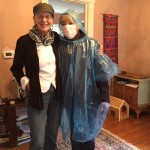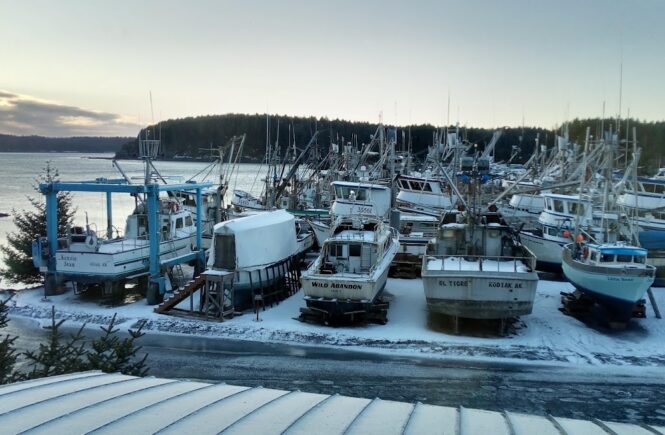The final writing of my book on Icelandic seawomen took a strange turn almost a year and a half ago, when I noticed I was uncharacteristically getting short of breath while riding my bike uphill on my daily commute home. On New Year’s Eve, 2014, at the insistence of friends, I went to the emergency room to get it checked out. The next thing I knew, I was being whisked to another hospital in an ambulance, and being given blood transfusions.
After a horrifying night (one New Year’s I wish never to repeat), I was diagnosed with a rare, potentially lethal, blood disorder called aplastic anemia. For no known reason, my bone marrow had suddenly decided to stop producing sufficient blood cells. For the next year, doctors tried various treatments; they all failed. So then, the doctors told me that my last resort was a bone marrow transplant. The specialist said my chances of surviving this procedure were about seventy percent. “But without it,” he said, “your chances are zero. Without it, I can say quite confidently that within a year you will very likely be dead.”
With those odds, the transplant sounded like a great option.
Having a bone marrow transplant is like swimming in the current of a river where you know very large rapids lie ahead. You might hit a lethal rock, get sucked underwater by the undertow, get pushed into a side channel that leads over the ultimate waterfall–or you can get through the rapids to calmer waters on the far side. But, as the current gets faster and faster, all you know for certain is that very soon you will lose all control, all you can do it try to keep your head up, your feet forward, stay alert as much as possible, and keep swimming.
During the year of failed treatments, I had been able to go over the copyedits of the book and work on the Reykjavik museum exhibit on seawomen that opened June 2015 (although I did meetings from home via Skype instead of going to Iceland as had been previously planned). During a high point in my tenuous health, I was even able to fly to Reykjavik for the exhibit’s opening. But after that, things went downhill again; I began to need blood transfusions every week, then twice a week. My body is naturally very strong, but I could feel it deteriorating. “Poor thing,” I thought to myself. “You cannot do this much longer.”
So, I prepared for the transplant. I told friends and family how much I loved them. I made sure my final will was in order, and talked with my editor at the University of Washington Press about a document covering the final preparation of the book in case I didn’t make it through. “We haven’t really done that before,” she said in an even tone. “But I am sure we can figure out some document for it.”
The transplant was scary, but I was one of the very lucky ones: My transplanted bone marrow had to come from someone who was a near-perfect genetic match. The donor they found was a nineteen-year-old man, who my doctors think is likely from Europe. (The identity of the donor is not revealed for a year, and only then if both parties wish it.). I remain stunned by the mature generosity of this young man who went through some considerable pain to save the life of a stranger.
In preparation for the transplant, I underwent a week of fairly horrific “conditioning”at the hospital–infusions of a serum derived from horses, two types of chemo, full-body irradiation. The plan was to kill off my immune system and bone marrow so they would not get in a deadly internal fight with the donor marrow once the transplant had occured. In a delicate balance, the doctors brought me as close to the edge as they could, and then “rescued” me (a phrase used by one of the doctors) with the transplant. Then, if all goes well, the new blood and immune system gradually take over my entire body; this is so complete that my blood type has already changed to that of my donor.

After several weeks in hospital, I was allowed to come home, still with tubes coming out of my body, and forbidden to go more than thirty minutes from the hospital in case any emergency were to arise. And here I was so very lucky again: I was in good health when I got ill, and I also have a remarkable group of friends, family, and my partner—their constant support and good energy meant, and mean, so much. I do not know how I could have got through this without them. The people at UW Press have also been wonderful.
Now I am three months past the transplant, and this week marks the end the “critical phase.” This week I will have the tubes taken out of my body, and will be free!! to go further afield, into my beloved mountains, to walk by the sea, and to visit people in nearby towns. I am not completely “well”; my immune system is still lfragile, infections could still kill me. I have a long way to go to recover my strength and a new stability in my health. But, while taking all this into consideration, I can also now plan for a future. All of this gives the release of the seawomen book extra meaning for me, my ability to give talks and participate in planned events take on new joy. I will use this blog to let you know how this all goes–and of new projects and plans as they emerge. Yippee!
And for now, we can revel in this spring–its succulent rains, uncertain sunlight, the eddied scents of cherry blossoms, tulips that brave each tenuous dawn, clematis that flowers everywhere its tentacles touch, and the humble field daisies with their promise of summer warmth.
In this, my best to you all.
